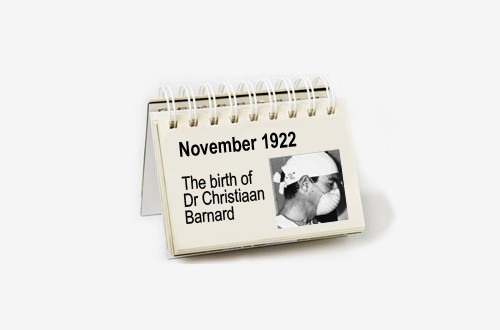
Since the International Society for Heart and Lung Transplantation (ISHLT) began to keep global records in 1983, more than 100,000 heart transplantations have been carried out in people across the world.
The true figure is likely to be even higher, however, as reporting to the registry is only mandatory in the US, where there has been a stable rate of about 2,300 heart transplants a year over the past two decades.
It’s an operation that once seemed impossible, but now the procedure of replacing a diseased heart in a living human with a working heart from a recently deceased donor has become somewhat routine in developed nations.
As with any great advance in healthcare, there had to be a first time, and that responsibility fell into the hands (and surgical knife) of Dr Christiaan Barnard.
Born in a small South African town on November 8, 1922, Dr Barnard was one of five sons of a church pastor, including one who died from heart disease at the age of five.
Perhaps spurred by the death of his brother, Dr Barnard studied medicine at the University of Cape Town. From there he did an internship at the Groote Schuur Hospital – an institute he later joined as registrar in the department of surgery once he received his MD.
His career as a surgeon took him to the US in the late 1950s, after which he returned to South Africa where he was eventually appointed associate professor in the department of surgery at the University of Cape Town in 1962.
It was five years later, while still in this position, that Dr Barnard played his part in one of the most celebrated moments in healthcare during the 20th century.
Having already performed the first kidney transplant in South Africa in October, 1967, and with numerous trials on animal subjects under his belt, Dr Barnard was one of several men worldwide ready and prepared to undertake the procedure. He was also one of the few who had a willing patient in the form of Louis Washkansky – a South African grocer with both diabetes and heart disease who, by all accounts, did not have long to live.
As noted by Dr Manuel Antunes in an obituary to the surgeon, Dr Barnard explained Washkansky’s choice: “For a dying man it is not a difficult decision because he knows he is at the end. If a lion chases you to the bank of a river filled with crocodiles, you will leap into the water, convinced you have a chance to swim to the other side.”
All that remained for all vying teams was a donor heart – and a car accident on the afternoon of December 3, 1967 gave Washkansky just that.
Denise Darval was walking through the streets of Cape Town with her mother, when a car ran into both of them. Denise’s mother died at the scene, but Denise was still alive when she reached the hospital. She had suffered multiple head injuries, however, and could only be kept alive with life support, being essentially brain dead.
The evening of the accident, the team at the hospital stopped trying to revive Denise, and her father gave permission for her still-healthy heart to be used in the first operation of its kind anywhere in the world.
Washkansky survived the operation, and the procedure was declared a success, with Dr Barnard appearing on the cover of Time magazine and taking many of the plaudits for this pioneering advance in healthcare.
“His achievement was hailed as a near-miracle,” said Raymond Hoffenberg in a British Medical Journal article in 2001.
It was a short-lived miracle for Washkansky, however, as just 18 days after his operation he contracted pneumonia, due to the immunosuppressant drugs he was taking to allow his new heart to be accepted by his body, and died.
Nevertheless, a feat once thought impossible had been achieved, spurring other surgeons to attempt heart transplants, including Dr Adrian Kantrowitz, who performed the first operation of its kind in the US just three days after Dr Barnard carried out his procedure. These early operations had varying degrees of acheivement, with few matching the success Dr Barnard’s second patient Philip Blaiberg who survived for 19 months following his transplant.
The main problem was that which befell Washkansky – post-operative problems with immunosuppressant drugs – although things began to change with the use of ciclosporin.
Developed by Sandoz (now part of Novartis), the drug improved success rates in preventing organ rejection while minimising side effects. It received US approval in 1983.
Since then, even more immunosuppressant products, including Astellas’ Prograf (tacrolimus) and Pfizer’s Rapamune (sirolimus), have come to the market, improving the post-operative health of patients and helping to turn Dr Barnard’s miracle into a routine.
The Author
Tom Meek, web editor of PMLiVE




